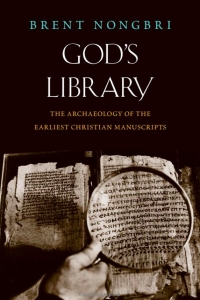PSI 11.1200 is a collection of fragments of a papyrus roll that contained Plato’s Gorgias (LDAB 3770). Framed together in the Biblioteca Medicea Laurenziana in Florence, the fragments were excavated at Oxyrhynchus by a team led by Evaristo Breccia in the spring of 1932. Along with the fragments of Plato, the frame also contained another fragment from a different roll. This fragment also came from a papyrus roll and was written in a script that was similar to, but clearly distinct from, the the writing of the Plato fragments. Its text was not part of the Gorgias. In fact, it was not part of of any known text. More curious still, it contained abbreviations: ⲑⲥ (=θεος) and ⲑⲱ (=θεω), so-called nomina sacra, abbreviations for certain words that appear in Christian manuscripts. In 1980, this fragment was published by Antonio Carlini as PSI 11.1200 bis (LDAB 4669). Here is the papyrus along with a transcription as printed in the more recent edition of Dieter Lührmann:

PSI 11.1200 bis, unknown Christian text; image source: PSI Online; transcription from Lührmann, Fragmente apokryph gewordener Evangelien
Carlini noted some verbal parallels with known Christian writings but refrained from positively identifying the text on the papyrus. He assigned the manuscript on palaeographic grounds to the second century. There is a lot we could say about this papyrus (Why hasn’t such a seemingly ancient Christian manuscript stirred more interest? Was it, like the Plato fragments, excavated at Oxyrhynchus?). For now, I simply want to point out that Carlini and others have described the style of script as the “Roman Uncial” or “Rounded Majuscule,” the same script as the Hawara Homer. The seemingly Christian and eschatological contents of the text (ⲉⲥⲭⲁⲧ… in line 1 and [ⲉ]ⲥⲭⲁⲧⲁ in line 4) would appear to sit somewhat awkwardly with Cavallo’s thesis that this particular writing style was distinguished by its “profane” or “pagan” character. Along with the chronological difficulties with individual manuscripts like P.Oxy. 32.2624 that I noted in my last post, this observation causes me to have a number of reservations about the particular imagined cultural setting for the script and the chronological “development-perfection-decline” model that Cavallo proposed for the “Rounded Majuscule.”
Sources:
Carlini, Antonio. “Amicus Plato …: a proposito di PSI XI 1200, Gorg. 447 B ss.” Pages 41-45 in Rosario Pintaudi (ed.), Miscellanea Papyrologica. Florence: Gonnelli, 1980.
Lührmann, Dieter and Egbert Schlarb. Fragmente apokryph gewordener Evangelien in griechischer und lateinischer Sprache. Marburg: N.G. Elwert, 2000.


Pingback: Color Images of the Hawara Homer Online | Variant Readings